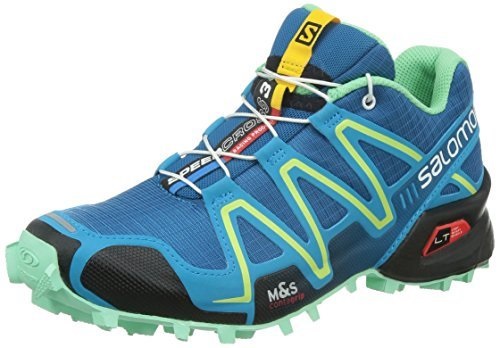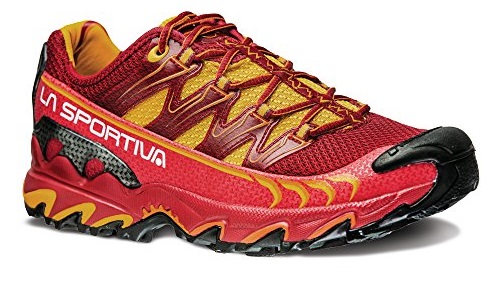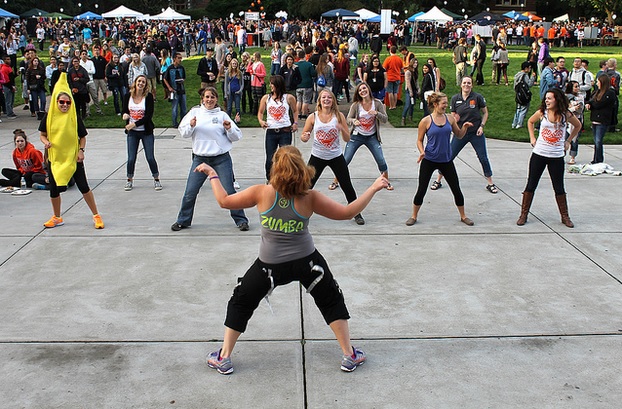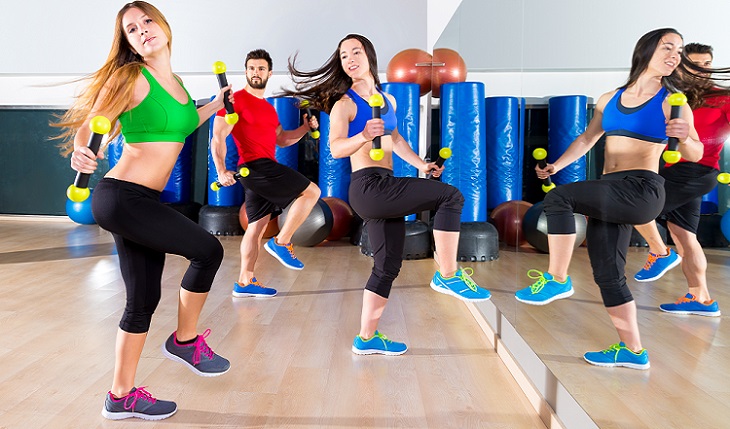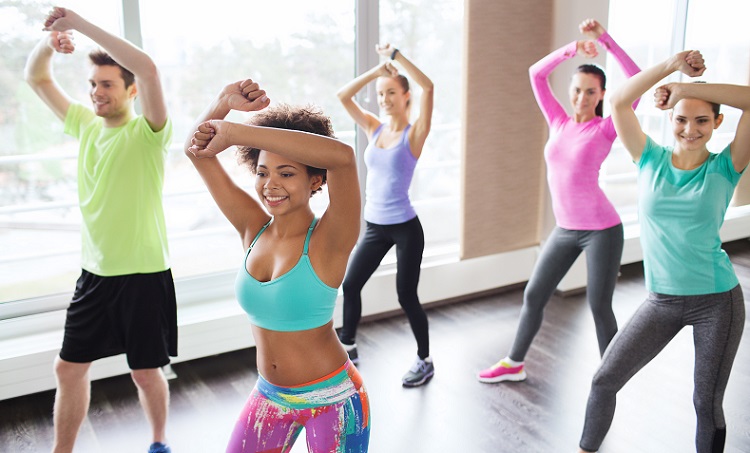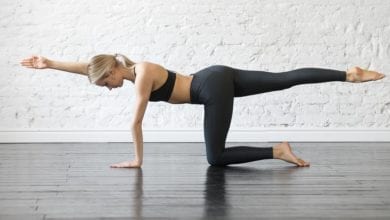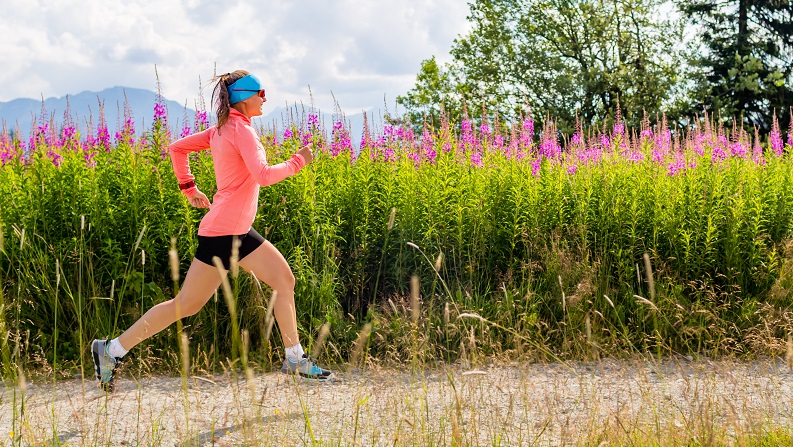
Our Editors independently research, test, and rate what we feel are the best products. We use affiliate links and may receive a small commission on purchases.
Trail running takes your normal running regime up another level by moving your typical running workout into nature. Whether it be through the woods, or near the water, trail running fuels our human desire to be outdoors.
Runners are flocking to the trails for various reasons, including less stress on the body than running on asphalt, and the connection to the great outdoors.
Although trail running is typically thought of as an individual exercise, trail running races, and group trail running has experienced a recent increase in popularity.
Best Trail Running Shoes For Women
| Salomon Speedcross 3 Trail Running Shoe | Merrell Vapor Glove 2 Trail Running Shoe | La Sportiva Ultra Raptor Mountain Running Shoe | |
|---|---|---|---|
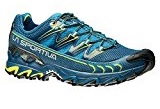 | |||
| Sole: | Rubber sole | Rubber sole | Vibram sole |
| Upper: | Textile and synthetic leather | Breathable mesh | Fabric mesh and synthetic |
| Sizes: | 5 - 12 | 5 - 11 | 5.5 - 11 |
| Waterproof: | Yes | No | No |
| Best For: | Trail running and hiking | Barefoot style trail runner | Trail running on rugged & rocky trails |
Quick Answer: The 5 Best Rated Women’s Trail Running Shoes
- Salomon Women’s Speedcross 3 Trail Running Shoe
- Merrell Women’s Vapor Glove 2 Barefoot Trail Running Shoe
- La Sportiva Ultra Raptor Mountain Running Shoe
- ASICS Women’s GT-2000 4 Trail Running Shoe
- Women’s Olympus 2 Trail Running Shoe
Our reviews of the top rated women’s trail running shoes with our buying guide and comparison table below will help you choose the right pair for you.
Trail Running Shoe Reviews
#1 Salomon Women’s Speedcross 3 Trail Running Shoe
- Upper: Textile and synthetic leather
- Soles: Rubber
- Sizes: 5 – 12
- Waterproof: Yes
The Salomon Speedcross 3 trail running shoe combines lightweight, fit and a durable design. The Speedcross 3 is water resistant, with wide heel for better surface contact.
The midsole is lower to the ground than traditional running shoes, which reduces the risk of injury, and the outsole boasts better grip.
With OrthoLite insoles and chevron shaped lugs on the bottom to grip rocky terrain, this shoe is ideal for comfort, safety, and protection.
These Salomon trail shoes are top performers and runners flock to them with repeat business.
These shoes are easy to break in, provide substantial arch and ankle support, and are made of fine craftsmanship.
Perfect for sensitive feet, or for difficult or rugged trails, the Salomon Speedcross 3’s are the best trail running shoes for hiking.
#2 Merrell Women’s Vapor Glove 2 Barefoot Trail Running Shoe
- Upper: Textile
- Soles: Rubber
- Sizes: 5 – 11
- Waterproof: No
The Merrell Vapor is a very different shoe than the others from our list. Unlike to the others with a thicker sole, these are “minimalist” shoes and are designed to feel like you are barefoot.
They can be worn without socks and in fact you are better off not wearing them while running in these shoes.
The mesh upper and footbed of the shoe has been treated to prevent the build up of microbes that would normally cause odors while wearing them without socks.
They have no cushioning and while this sounds like a bad thing, new research shows it’s actually best thing for your feet.
When they need to the be cleaned you can just toss them in the washing machine and either dry them on a gentle cycle or better just let them air dry.
They mesh design of the shoes will dry quickly and is breathable to keep your feet cool and dry while you are running.
I really like these shoes, it feels like you are not wearing anything on your feet and they are super comfortable! These are my top pick for the best women’s trail running shoes.
#3 La Sportiva Ultra Raptor Mountain Running Shoe
- Upper: Fabric mesh and synthetic
- Soles: Vibram
- Sizes: 5.5 – 11
- Waterproof: No
This all terrain shoe is built for long distance and unpredictable trails. The Thermoplastic Polyurethane (TPU) Lacing Harness and TPU Transkinetic Heel Stabilizer provide strong foot support.
Sticky FriXion rubber outsoles provide unmatched grip on the ground and unmatched traction.
These trail running shoes for women are ideal for runners who have high arches, narrow heels or wide, square toes.
Runners love these shoes because they require little to no effort to break in, and provide safe performance in wet or slippery conditions.
The Ultra Raptor Mountain Running shoe is sturdy, long lasting, and with important features like rubber toe guards, and leather heel slip pads, you can be sure that these shoes will provide long term comfort.
The Raptor’s are on the short list for the best trail running shoes for women.
#4 ASICS Women’s GT-2000 4 Trail Running Shoe
- Upper: Mesh and Synthetic
- Soles: Rubber
- Sizes: 6 – 12
- Waterproof: No
ASICS is known for its mission to create footwear that connects the body and the soul in comfort, and this shoe certainly lives up to those expectations.
This shoe is modeled after the natural heel strike to toe off motion of the foot. The Fluid Ride technology cushions the foot and provides lightweight durability.
Perfect for reducing shock during impact, providing perfect midfoot support, this shoe is made to power through all conditions.
Runners have flocked to this shoe because of its perfect stability and balanced level of comfort. Many find that the shoe is so comfortable that it has transitioned to their shoe for everyday use.
One of the most popular features of this shoe is the “bunion windows” which allow the runner to have additional space and comfort in the bunion area.
For a shoe that combines comfort and bounce, the ASICS is an unmatched women’s trail running shoe.
#5 Women’s Olympus 2 Trail Running Shoe
- Upper: Fabric and Leather
- Soles: Rubber
- Sizes: 5.5 – 10
- Waterproof: No
This heavy duty shoe is ideal for maximum traction and maneuverability. The prime feature of this trail running shoe is its unmatched comfort.
Soft and flexible upper support, and a ‘bound bottom’ layer cushion the foot throughout all types of terrain.
The GaiterTrap technology prevents build up underneath the shoe ensuring an efficient, and relaxed running experience.
This shoe is a little different than the traditional, tight running shoe fit you might be used to. The thick sole and “neutral” style is ideal for those with high arches, or those who require little support.
Popular for their ability to reduce pain from shin splints and bunions, these shoes are the perfect option for those who want the best trail hiking shoes for women.
Women’s Trail Running Shoes Comparison Table
| Trail Running Shoes | Upper | Sole | Sizes | Best For | Rating | |
|---|---|---|---|---|---|---|
| Salomon Women’s Speedcross 3 | Textile and synthetic leather | Rubber | 5 - 12 | Trail running and hiking | 4.6 / 5.0 | |
| Merrell Vapor Glove 2 Barefoot | Breathable mesh fabric | Rubber | 5 - 11 | Barefoot style trail runner | 4.4 / 5.0 | |
| La Sportiva Ultra Raptor | Breathable mesh fabric | Vibram | 5.5 - 11 | Trail running on rugged & rocky trails | 4.4 / 5.0 | |
| ASICS Women's Gel-Kahana 8 | Breathable mesh fabric | Rubber | 6 - 12 | Trail running on rugged & rocky trails | 4.3 / 5.0 | |
| Olympus 2 Trail Running Shoe | Breathable fabric and Leather | Rubber | 5.5 - 10 | Trail running, hiking, fastpacking | 4.2 / 5.0 |
How to Choose the Best Trail Running Shoes For Women
- Considerations For Trail Running Shoes
- How Can I Start Trail Running?
- What Are The Benefits Of Trail Running?
- Trail Running Safely
- FAQS About Women’s Trail Running Shoes
- Tips for Buying Trail Running Shoes
- The Time to Start Is Now
Considerations For Women’s Trail Running Shoes
While trail running is a great way to improve your overall health, there are some things to keep in mind. Primarily, run smart! Only begin running after a thorough warm up and stop if you feel any pain.
Running is repetitive on the joints, and can strain the body if not performed properly. It is imperative to have sturdy, well-fitting shoes, remain hydrated, and a commit to stretching before and after your workout.
Be on the lookout for signs of new injuries including irritation in the joints or pulled muscles. Most running injuries are signs of overuse or improper form. With any type of running program, it is important to keep a lookout for the following symptoms:
Knee Pain
If you experience pain in the knee when performing bending motions such as going up stairs or squatting, can indicate a condition called ‘Runner’s knee’.
Shin Pain
Pain along the front of the leg, below the knee, and extending towards the feet can indicate shin splints. Shin splints are common among those with flat feet, and frequently occur when you increase workout intensity or duration.
- Pain in the heels: Sharp pain in the heels can indicate a bone spur. Pain is frequently felt first thing in the morning, or walking after a long period of rest. Pain can also appear when one has been on their feet too long.
- Piriformis syndrome
Irritation or damage to the piriformis muscle, located between the groin and buttocks, can lead to a more severe condition called Piriformis syndrome. If you experience pain in this location, you must take a break and pursue stretches and home rehab options to heal the muscle.
If you ‘push through the pain’ it can lead to a potentially permanent condition. The condition is extremely painful and due to its location can also cause irritation to the sciatic nerve.
While these conditions can usually be addressed with rest, ice, and stretching, it is important to discuss any pain or changes with your doctor
Uppers
Trail running shoes should be well-cushioned yet lightweight. Unfortunately, many manufacturers have not figured out how to combine these two features properly. This is why you should look for a pair mainly comprised of mesh uppers.
Mesh is extremely light yet can be made more durable and supportive with overlays. Not only that, but it allows for airflow which will leave your feet feeling cool and dry, even on long distance runs.
Even if you’re on a great run, sweaty feet can really kill your mood and even negatively affect your performance.
Soles
Rubber is by far the most common material for the soles of trail running shoes, though occasionally you will find some made of synthetic materials like Vibram. Rubber is our material of choice, as it’s relatively cheap, very durable and does add a bit of springiness and grip to a shoe.
Grip is crucial for any trail running shoe, but even more if you’re going to be running on slippery or wet surfaces. If you live in a rainy area, then you need to look for a pair with rubber soles that will essentially stick onto the ground and keep you confident on your feet.
Durability
No matter how frequent of a runner you are, durability is essential in any trail running shoe, but more so for those who run on rough surfaces.
With that being said, trail running shoes are generally very well-constructed and made with high-quality materials. Even if you’re someone who likes running shorter distances, you’ll definitely be able to tell the difference with a higher-quality shoe.
These will hug your feet, adding extra support while also letting them naturally roll heel-to-toe without issue. While durability is often directly affected by the mileage you put on your shoes, just about every model we reviewed above will last you for at least a year of consistent use.
Energy Transfer
Many of us who run long distances like to have a shoe that has good energy transfer which helps over long distances.
So what you need in these cases is a good pair of shoes that are made to be responsive. This is even more true if you overpronate and those with flatter feet need the most stability to try and prevent the foot from collapsing excessively.
Responsive shoes usually come made with rubber outsoles along with some kind of flex grooves. The combination of these two features allow for snappy shoes that will have the heel-to-toe transfer run smoothly and quickly.
How Can I Start Trail Running?
The first major step in trail running is obtaining the right equipment. Special trail running shoes are available, and differ from traditional running shoes in many ways.
“Trail shoes” are designed to hug the terrain through the use of textured bottoms made of lugs, and protect the feet better than road running shoes. They have stronger mesh, and better design around toes for added protection. They are built to last longer and endure harsh use.
Because running in the outdoors can be messy, it is important to choose apparel that you don’t mind getting dirty. Flashlights, water bottle, insect repellant, basic first aid items, and hydration vests for personal items are also great tools for trail running.
Your next step is to choose a trail. Find a trail in an area you know well, and stick to terrain that suits your fitness level. You can find trails that vary in level and distance.
Finding a short trail to start with is ideal. Carefully map out the area, and learn about any potential dangers including animals, plants, and obstacles.
As with any exercise, it is important to begin slowly. This is especially important for those who are beginning trail running after a long period of sedentary, or minimal activity levels.
When it comes to running, the goal is to build up stamina over time and prevent injury, so it is key to start at short, slow intervals. Even walking through the varied terrain is a great start to building up to running.
Video: How to avoid common mistakes trail running.
Practice proper running technique and listen to your body. Although the goal of running is to stretch the limits of the body, but you should never feel pain or extreme discomfort. Take short, deliberate strides, at a manageable pace, and keep the body weight over your feet.
Always scan the ground in front of you for potential dangers, and only run in clear weather and daylight- though trees often shield the sun in large parts of the trail.
Keep in mind that trail running differs immensely from running on a typical road. Trail running is practiced on rapidly changing terrain, and you must get in the habit of lifting your feet significantly higher than if you were running on asphalt.
Lifting the feet higher allows you to avoid any potential debris on the trail, and gives you extra time before your next step to avoid potential hazards.
Experienced runners will also find it imperative that they begin running at a slower pace than usual when transitioning to trail running for the first time.
The ground will feel differently and your body will need practice getting used to the changes. Since the terrain can change quickly on the trails, it is important to learn when it is necessary to hike instead of run.
Steep inclines and rapid drops are frequent on some trails, so don’t expected an uninterrupted run.
What Are The Benefits Of Trail Running?
Trail running is one of the best ways to improve your overall health. Not only does it boost your metabolism if weight loss is your goal, it builds overall strength and cardiovascular health.
Studies have shown that a systematic running program improves immunity, lowers risks of blood clots and heart attacks, prevents osteoporosis, and has been shown to reduce the risk of breast cancer in women.
Running not only helps your physical health, it boasts many mental health benefits as well. Running allows our brains to release hormones called endorphins that fight off depression and anxiety.
This release of endorphins has a natural, positive impact on our brains leaving us feeling focused and refreshed.
Running is also a great stress buster and ideal mechanism for regulating our bodies. Studies reveal that those who run on a consistent basis have better sleep and increased energy levels.
Though running has many benefits, running on flat terrain for long periods of time on a daily basis can also be harmful to your joints, muscles, tendons, and ligaments.
Trail running provides a unique experience because of the varied terrain. The changes in terrain force your body to switch between rigorous short spouts of running, to strenuous climbing—all with intentional balance.
This balance comes from focusing closely on the in particular changes. This deep concentration contributes to an increased over-all feeling of well-being.
Additionally, many trails have spots of picturesque views to take in while you run. Best of all, it increases leg strength more efficiently than traditional running, due to the more varied terrain of the trails.
Trails are also more shock absorbent on the feet than asphalt, making trail running a better option for your joints. The attention to balance adds extra emphasis on building your core, which creates over-all strength and chiseled abs.
Arguably, one of the best benefits of trail running is that it gets you out in nature. With all of the hectic demands in our day to day lives, it is important that we reconnect with the outdoors.
The July 2010 issue of the Harvard Health Letter reveals that being outdoors increases the level of natural Vitamin D in our bodies. This is important because studies show that Vitamin D is responsible for proper bone health, including fighting off osteoporosis, and contributes to good immune and cardiovascular health as well.
Vitamin D deficiency is a significant problem in Americans. Some people raise their vitamin D levels in the summer, but by the time late fall rolls around, they have already depleted the stored up vitamin D—making them more susceptible to colds and the flu virus.
Trail Running Safely
Communicate clearly with others when you are leaving, where you will be, and what time you expect to return. Though it is ideal to trail run with a partner, sometimes that may not be an option.
If you go alone, make sure to let someone know where you are and when you expect to be done and then, check back in with them.
Since trails are often secluded, it is important to consider safety and always be aware of your surroundings. Although music is tempting to drown out the silence, leave headphones at home, so that you are always well aware of your surroundings.
If you have a dog, consider bring them along, for added safety. Large dogs in particular are easy to train on the trails and usually do well adjusting to the changing terrain.
Even though it is not always ideal to carry items with you while running, it is important to at least have your cell phone and ID in case of an emergency.
Bringing mace or a small defense weapon can be helpful, but it also important to know general first aid and basic plant and animal identification for the area. Always stick to the trails and keep an eye out for tree roots or unpaved areas that might signal dangerous terrain.
Getting Started:
If you think trail running is a great option for you to reap all of the great benefits of running, and spend some quality time outdoors, the first thing you need is a great pair of women’s trail running shoes! Here are some things to keep in mind when shopping for your first pair:
Avoid:
- Shoes with unstable laces or upper components
- Discomfort in the toes (this will only increase when running downhill),
- Shoes that have too much movement between the heel and heel padding
- Shoes without lugs or overly narrow lugs on the bottom
- Shoes that are too lightweight (this suggests the shoe may have less support and protection)
Try:
- Shoes with sturdy laces
- Shoes that are designed to fit your style of foot (may require professional fit)
- Snug but not tight
- Supportive midsoles
- Shoes that work well with added supports like shanks, plates, or absorbent socks and orthopedic inserts.
FAQS About Women’s Trail Running Shoes
Trail running fuels our desire to be outdoors among nature, giving us a great connection to the outdoors. It’s also less stress on the body than running on asphalt. And it takes your normal running routine up another notch.
And once you’ve grown to love trail running, you’ll need the right shoe for the type of trail running you prefer.
Q: How does size compare with other shoes?
A: Many trail running shoes run differently size wise, than normal shoes, because they are made to give more support to the midsole and ankle.
Q: Can’t I Use Any Running Shoe?
A: No. There is a difference between road running shoes and trail running shoes. Trail running shoes have “lugs” on the soles, which are a series of indentations which can grab the terrain (rocky or flat) and give the runner a better purchase.
Q: Can I Use Trail Running Shoes in Any Weather?
A: In many cases yes! Like any other shoe, a little research goes a long way. Some shoes will be water resistant but not waterproof. And a very few shoes are neither.
Q: What Are the Benefits of Trail Running?
A: Trails are a shock absorber for your feet and better for your joints than asphalt. And the added balance contributes to building your core. Also, the changes in terrain force your body to switch running between short spurts, to strenuous climbing, increasing leg strength.
Q: What should I look for in a Trail Running Shoe?
A: You should look for lugs on the bottom of the shoe which give you traction on the trail. The shoe should also be heavier than most shoes, indicating more .support for your foot.
Tips for Buying Trail Running Shoes
Investing in a pair of women’s trail running shoes is an important venture. You need to ensure you get a pair which is comfortable to wear and also have the support you need as you run both your neighborhood trails and hiking trails.
Tip # 1: Consider Your Environment
If you plan to run during winter or rainy seasons, it’s best to ensure you have waterproof shoes. These shoes will ensure your feet stay dry while you run in snow or rain. In drier climates a shoe which is water resistant is fine.
The terrain in which you’ll be using the shoes is also important. Trail running shoes have lugs which grip the surface of the ground. There are different types of lugs for different types of terrain. The larger the lug, the more rocky or difficult terrain the shoes can support.
Tip #2: Consider the Purpose
Trail running has become a serious sport; it’s no longer an individual endeavor. Several different types of races occur throughout the year all over the world. Before purchasing your shoes, you’ll need to know what type of environment you’ll be running in and what the shoe can handle before lacing up those strings to your shoes.
Tip #3: Fit
The fit of your trail running shoe is very important. If it doesn’t support your feet correctly, you could get injured. Trail runners need to have a sturdy lacing design, which will help the shoe fit snugly but not too tight.
There should be support through your midsoles to help balance your heel-toe strike as you run and your toe-heel strike as you climb up. And, the shoes should be just heavy duty enough to support any weight you may add, such as shanks, plates, absorbent socks, or orthopedic inserts.
Tip #4: Durability
How long will trail running shoes last? When running on your own, you don’t often think about this question. But when running marathons, you might have to buy more than one pair of shoes if they don’t last long. However, most trail running shoes were designed with the intent to last.
Tip #5: Don’t Settle for Less
There are a wide variety of styles and prices for women’s trail running shoes available. When choosing shoes, don’t settle for mediocre; but choose shoes which will fit your needs and go beyond. Your feet are important and are the focal point of physical health for the long term..
The Time to Start Is Now
Trail running is a great opportunity to improve your health and connect with the outdoors. Although it seems comparable to traditional street running, trail running requires specialized equipment, changes in technique, and important safety considerations.
Being informed is the best asset you can begin with as a trail runner, and once you learn all of the required introductory information, you will be able to supplement your fitness routine with a method that improves not only your physical, but mental health as well.
How We Researched
To come up with the top trail running shoes, we researched a variety of sources for reviews such as Best Buy, Walmart, Target and Sears along with our own personal experience.
The authors consulted sources such as online magazines for research and reviews unbiased information.
By using Fakespot.com we tried to eliminate fake reviews and use only genuine ones.
With so many options available, the authors narrowed down the selections by using products they felt were the best value for the money.
The staff authors have a wide and varied background as fitness trainers, yoga instructors and runners. The authors have decades of experience and are eager to share their knowledge with readers.
In order to narrow down the options, we used personal experiences plus recommendations from other trainers and instructors.
Sources
I hope this guide was helpful for finding the best trail running shoes for women to fit your needs. If you want to comment or recommend a pair of shoes I didn’t include, please use my contact form to get in touch.
Have fun and enjoy your workout!

